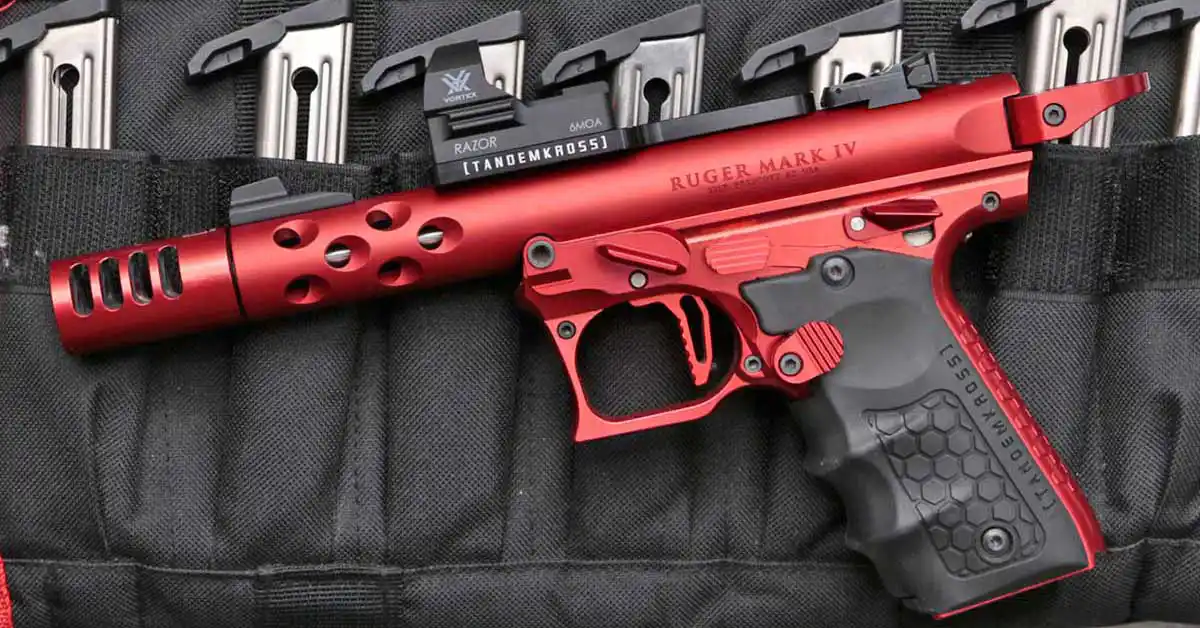An evolution of a design first introduced in 1949, the Ruger Mark IV pistol is a favorite of enthusiasts today. That’s due to a couple of factors. First, Ruger offers the pistol itself in a wide variety of configurations, and even color options. Next, the aftermarket support for this pistol is huge. Combined, it’s no surprise that this little .22 LR firearm has such a huge following. With that in mind, I figured I’d offer a quick overview of some of the options available. This isn’t a comprehensive guide, but rather an educational primer on what can be done to this versatile and popular pistol.
First, a little background
Initially called the Ruger Standard Model, this was actually the product that launched the company we know as Sturm, Ruger & Co., Inc. Bill Ruger designed it, and then turned to his friend Alex Sturm for the funding to get it into production. Amusingly enough, Sturm’s biggest contribution outside of the initial start-up money, was the iconic red eagle medallion that remains as the company’s logo today. Thanks to their innovations in design and manufacturing, the Ruger debuted with a very reasonable retail price of $37.50.
Subsequent models were referred to as the Mark II III, and eventually the IV. Within each model there were plenty of variations in barrel length and design, from tapered blue barrels to slab-sided stainless. One constant prior to the Mark IV was the somewhat vexing takedown and reassembly process. This was solved with the Mark IV, and its unique tool-free, one-button takedown which made field-stripping and cleaning easy. That’s the model which won over new enthusiasts, and the focus of this article.
Variety, and then some
Currently, Ruger offers two major variants, with a variety specific to each design. The difference is the lower, or grip frame. One variant uses the original style metal grip frame, while the other uses a polymer frame with a grip angle similar to the 1911. This newer model, the 22/45, seems to be the more popular version lately. Part of that is due to the Ruger Mark IV Lite models, which have a steel barrel inside an aluminum sleeve. They are available in an assortment of colors, with different lightening cuts in the barrel’s sleeve. The good news is that Mark IV uppers will fit on either version of the grip frame.
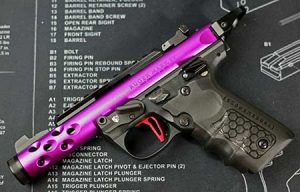
If the eight separate models of the Ruger Mark IV weren’t enough, distributor exclusives offer more options. Ruger doesn’t sell direct, or even ship direct to dealers. Instead, they only sell to distributors, who then deliver to their dealers. Different distributors can request their own options, usually colors that are only available from their preferred dealers. In summary, there is no shortage of variety for anyone looking to pick up a Ruger Mark IV pistol.
How big is the aftermarket for the Ruger Mark IV?
While it’s common enough to buy a factory Ruger Mark IV and be happy with it, if you want something custom, it’s likely available. Pretty much every single part is available from aftermarket vendors. Triggers, grips, safeties, barrels, bolts, and even complete uppers and grip frames. There are also a host of parts that the factory never offered for the Ruger Mark IV. That includes slide-racking devices, thumb rests (AKA gas pedals), magazine extensions, and even optic mounting plates.
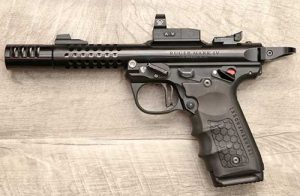
A handful of larger companies offer the bulk of aftermarket options, from individual parts to complete pistols, some of which have zero Ruger parts. At the other end of the spectrum are smaller companies that specialize in niche products. Many deal in a single product, like the aforementioned optics mounts, or thumb rests, and at least one offers a novel way to add an under-barrel rail. If you want it, chances are that someone offers it.
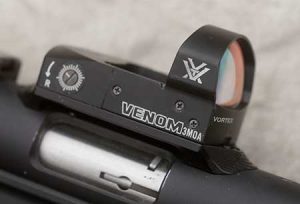
What about a companion Ruger Mark IV rifle?
For some enthusiasts, there’s a certain appeal to having a rifle or carbine that accepts the same magazines as their pistol. Although Ruger doesn’t offer such an option, at least one aftermarket company has stepped up and developed their own rifle-length upper. Thanks to the simplicity of separating the upper from the grip frame, swapping out the pistol upper for the carbine upper is a quick and painless process.
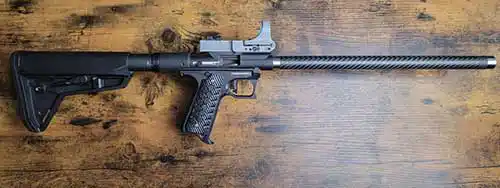
What’s not painless is the cost to do so. Since the upper (barrel and bolt housing) of the Ruger Mark IV is the serialized part, a new upper is treated like a firearm. That means it’s regulated as though it was a complete firearm. You can’t just walk into your local firearms proprietor and purchase one over the counter. Instead, it’s necessary to fill out a form 4473 and have it transferred via a licensed dealer. While the research and development to produce a product like this is not cheap, the extra regulatory paperwork certainly adds to the final cost. Probably not a huge barrier for anyone determined to have the ultimate Ruger Mark IV kit of pistol and rifle though.

So many options, so many applications
With all these options, there are plenty of use cases for the Ruger Mark IV. Some enthusiasts just want an inexpensive plinker, which is what the .22 LR cartridge is well known for. Others use theirs for hunting or competition. With the ever-growing popularity of suppressors, they also make great hosts. Many of the available models come with a threaded barrel, making it easy enough to enjoy some quiet time at the range, or dispatching pests on the back 40. Although Ruger does offer “Tactical” versions of the Mark IV, that’s really just marketing-speak for a rail on the top and underside of the barrel.
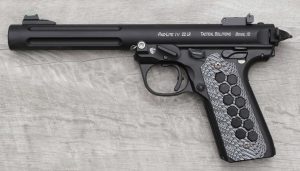
As you can see from the photos, anyone interested in getting a Ruger Mark IV with the intent of customizing it has no shortage of options. From a “first firearm” to all-out Steel Challenge competition rig, it’s an amazingly versatile platform. And new and innovative parts and accessories keep coming to market. If you’re looking for a fun and reliable rimfire pistol to fully customize “your way”, the Mark IV is hard to beat.
